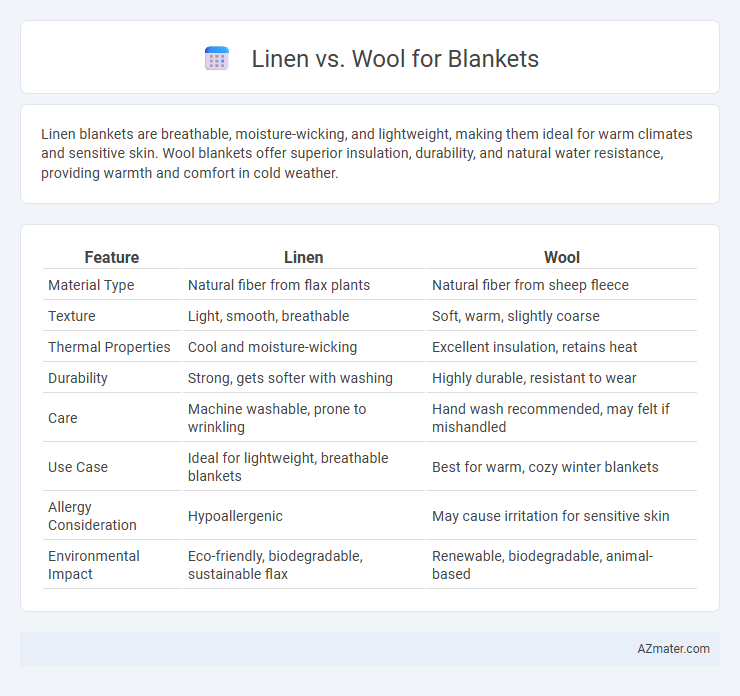Linen blankets are breathable, moisture-wicking, and lightweight, making them ideal for warm climates and sensitive skin. Wool blankets offer superior insulation, durability, and natural water resistance, providing warmth and comfort in cold weather.
Table of Comparison
| Feature | Linen | Wool |
|---|---|---|
| Material Type | Natural fiber from flax plants | Natural fiber from sheep fleece |
| Texture | Light, smooth, breathable | Soft, warm, slightly coarse |
| Thermal Properties | Cool and moisture-wicking | Excellent insulation, retains heat |
| Durability | Strong, gets softer with washing | Highly durable, resistant to wear |
| Care | Machine washable, prone to wrinkling | Hand wash recommended, may felt if mishandled |
| Use Case | Ideal for lightweight, breathable blankets | Best for warm, cozy winter blankets |
| Allergy Consideration | Hypoallergenic | May cause irritation for sensitive skin |
| Environmental Impact | Eco-friendly, biodegradable, sustainable flax | Renewable, biodegradable, animal-based |
Introduction: Linen vs Wool Blankets
Linen and wool blankets each offer unique benefits tailored to different needs and climates. Linen blankets are breathable, lightweight, and moisture-wicking, making them ideal for warm weather and sensitive skin. Wool blankets provide superior insulation, natural moisture resistance, and durability, perfect for cold environments and allergy sufferers.
Natural Origins: Linen and Wool Explained
Linen blankets, derived from flax fibers, offer exceptional breathability and moisture-wicking properties, making them ideal for warmer climates. Wool blankets, sourced from sheep fleece, provide superior insulation and natural temperature regulation, perfect for cold environments. Both natural fibers are sustainable choices with unique textures and durability, catering to different comfort preferences.
Texture and Feel: Comparing Linen and Wool
Linen blankets offer a crisp, breathable texture that feels cool and lightweight against the skin, ideal for warmer climates or those who prefer a smooth, airy touch. Wool blankets provide a plush, dense, and insulating feel, delivering superior warmth and softness, making them perfect for colder environments or cozy comfort. Both materials excel in durability, but their distinct textures cater to different tactile preferences and seasonal needs.
Warmth and Insulation Properties
Wool blankets provide superior warmth and insulation due to their natural fiber structure, which traps heat effectively and wicks moisture away, making them ideal for cold climates. Linen blankets, while breathable and lightweight, offer less insulation and are better suited for moderate temperatures or layering. The thermal regulation properties of wool outperform linen, ensuring sustained warmth even in damp conditions.
Breathability and Moisture-Wicking Abilities
Linen blankets excel in breathability due to their natural fiber structure, allowing air to circulate freely and keeping sleepers cool in warm conditions. Wool blankets possess superior moisture-wicking abilities, effectively drawing sweat away from the skin while providing insulation and warmth. Choosing between linen and wool depends on whether cooling comfort or moisture management in colder environments is prioritized.
Durability and Longevity
Wool blankets are renowned for their exceptional durability, with natural fibers that resist wear and maintain insulation over many years, making them ideal for long-term use. Linen blankets offer impressive longevity due to their strong flax fibers, which soften with each wash while retaining strength, providing a durable yet breathable option. Both materials excel in lasting performance, but wool's natural resilience makes it particularly suited for heavy, extended use.
Allergy Friendliness: Which is Better?
Linen blankets are highly allergy-friendly due to their natural hypoallergenic properties and breathability, which reduce dust mite accumulation and moisture buildup that often trigger allergic reactions. Wool, while insulating and moisture-wicking, can sometimes cause skin irritation or exacerbate allergies in sensitive individuals because of lanolin and its potential to trap allergens. For those with allergies, linen blankets offer a safer, more comfortable option by minimizing irritants and promoting cleaner sleep environments.
Care and Maintenance Requirements
Linen blankets require gentle washing with mild detergent and benefit from air drying to maintain their natural fibers and prevent shrinkage. Wool blankets demand careful hand washing or dry cleaning to avoid felting and use a wool-specific detergent to preserve softness and durability. Both fabrics should be stored in a cool, dry place away from direct sunlight to extend their lifespan and maintain texture integrity.
Sustainability and Environmental Impact
Linen blankets, made from flax fibers, require less water and fewer pesticides during cultivation, making them a highly sustainable choice compared to wool. Wool production involves livestock raising, which contributes to higher greenhouse gas emissions and significant land use, impacting the environment more substantially. Both materials are biodegradable, but linen's lower environmental footprint and renewable crop source make it a more eco-friendly option for sustainable bedding.
Choosing the Best Blanket for Your Needs
Linen blankets provide breathability and moisture-wicking properties ideal for warm climates and sensitive skin, while wool blankets offer superior insulation and durability suited for colder environments. Selecting the best blanket depends on factors such as desired warmth level, hypoallergenic needs, and maintenance preferences; linen requires gentle washing, whereas wool demands careful handling to preserve its fibers. Weighing these attributes helps ensure optimal comfort and longevity tailored to your specific sleeping conditions.

Infographic: Linen vs Wool for Blanket
 azmater.com
azmater.com